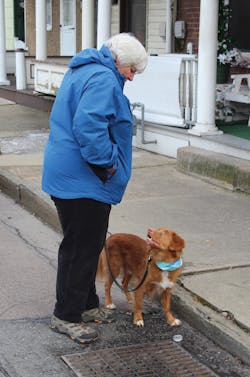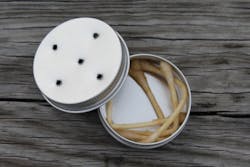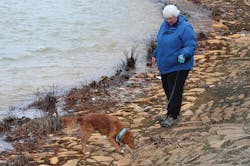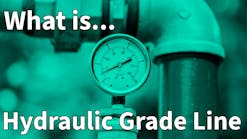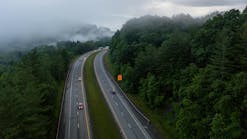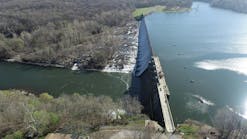“Sussey” the sewage-sniffing dog can detect leaks, illegal discharges and broken pipes
Located in North-central Pennsylvania, the Middle Susquehanna River Watershed is an approximately 11,500-square-mile area defined by the North and West Branches of the Susquehanna River, its tributaries, and drainage area. As the primary contributor to the Chesapeake Bay (about 50 percent of all freshwater in the Bay comes from the 27,500-square-mile Susquehanna River Watershed), a lot of eyes are on the Susquehanna and her health, so keeping the area “swimmable, fishable, and drinkable” is a serious job — one that a particular area resident takes very seriously.
Sussey (full name: “Little Keeper” Susquehanna) is an almost four-year-old Nova Scotia Duck Tolling Retriever whose main job is to sniff out discrepancies in the watershed, including leaks, overflows, and pollution. His handler is Middle Susquehanna Riverkeeper Carol Parenzan, who is one of about 340 water keepers around the world on six continents and in 44 countries.
“Just like a drug- or bomb-sniffing dog works to find a particular scent, Sussey has been trained to identify and seek out the smell of sewage,” Parenzan said.Sussey’s training involves weekly trips for Parenzan to wastewater treatment plants in the area, where she collects fresh samples in a vial. She then dips cotton swabs in the raw sewage and places them inside a metal tin with a punctured lid. The tin is hidden among other empty tins or outside on their walks together, where Sussey indicates that he has found his scent by making intense eye contact with Parenzan.
“Most people are trying to get rid of their sewage but I go to the wastewater treatment plant and get samples and bring them home with me because sewage for training has to be very fresh,” she said.
Obtaining samples from different wastewater treatment plants provides a “variety of compositions for training” so that Sussey can find sewage wherever it ends up.
Traditional leak or contamination detection can be costly and time-consuming and oftentimes requires samples to be taken and sent out to a lab, but Sussey works in real time.
“If we come in and we smoke our pipes, for example, we have to smoke the entire system and look for leaks, and at that point, we don’t know if that leak is raw sewage or if it’s something else. Since he only works for one thing — raw sewage — that’s what makes [using a sewage-sniffing dog] an advantage.”
Even so, the source of contamination, whether from a point source like a pipe or nonpoint source runoff from land, is often difficult to find and control. But a sewage-sniffing dog can quickly detect the presence of sewage, narrowing down areas where samples should be pulled. A dog can also sense sewage in places where it would be difficult or impossible to take a sample, like an outlet pipe or catch basin with very little or no water.
“If we suspect that there’s some integration of raw sewage into the stormwater system, he can help narrow down where we think those suspicious areas are, so when he alerts to a [particular area in the system], we can then grab that sample to confirm his findings at the source, [rather than trying to find that source after contamination is confirmed],” Parenzan said. “So, he’s our first line of defense, and the actual sample and the lab analysis are the confirmation of his findings.”
Parenzan, who has a background in subsurface utility and environmental engineering, began training Sussey when he was only seven weeks old, using techniques she learned while training seeing eye dogs. When Sussey was about a year old, Parenzan moved into nose detection training, working with a modified program designed by K9 Nose Works to teach Sussey to seek out the scent of sewage.
“Now we’re at the point where we’re taking raw sewage and we’re putting drops of it in buckets of water,” Parenzan said. “And so, I may have six or eight buckets of water lined up and maybe only one or two of those buckets has just a small amount of the raw sewage in it, and he is now alerting when he’s at that bucket.”
As Sussey’s training continues, Parenzan said he will be able to detect broken sewage lines, illegal or unknown connections to stormwater lines, failing septic systems, combined sewer overflow systems, or “any places where raw sewage has found its way into what should be a clean, freshwater environment.”
Maine-based Environmental Canine Services (ECS) has trained sewage-sniffing dogs and handler teams across the country since its founding in 2009. While ECS did not work with Parenzan or Sussey, the company has completed over 80 sewage detection or source tracking projects in 16 different states, and the company’s dogs have helped find and eliminate sources of pollution in Bayview State Park in Washington state and along Lake Michigan, among other spots.“We’ve had clients looking for leaks for 10 years without success, and our dogs have been able to pinpoint the exact location very quickly,” Karen Reynolds, ECS president, said.
“Municipalities can save time by not having to send crews out searching for leaks, and they can save money on testing, too. The ability of the dogs to discern animal versus human waste is also a money saver, as the only way to currently determine whether a pathogen is human material is through DNA testing, which can be costly,” Reynolds said.
Additionally, dogs can cover a large area in a short amount of time, tracking sewage and its source, where field crews would take a lot longer to do the same job.
“Sussey and I make a really good team,” Parenzan said, “because he can smell and I can kind of see beneath the ground until we can have a really good understanding of what’s happening, and we work with municipalities and engineers and other professionals that are involved in solving these problems in their systems.”
But Sussey’s work is not limited to finding leaks or contamination, as he has become a mascot of sorts for the Riverkeeper organization.
“People will come up to us while we are out working and ask all types of questions,” Parenzan said. “He’s my icebreaker with the community, so in many ways he does much more than detection. He’s our conservation canine, but he’s really a community liaison, too.”
Alanna Maya is assistant editor for WaterWorld and Industrial WaterWorld magazines. Email her at [email protected].
